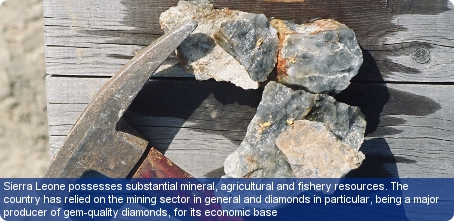Find a business in Sierra Leone

Sierra Leone is currently enjoying a period of relative political stability after more than a decade of instability and civil war. The country has a rich resource base, notably diamonds, rutile, bauxite, and gold, but this developing country is still underdeveloped. It has a GNI per capita of US$580 (2012), but has seen GDP growth of 7% per annum in 2008-12. The agriculture sector is the dominant sector, with the industry sector only accounting for 5% (2010).
While it possesses substantial mineral, agricultural and fishery resources, Sierra Leone’s economic and social infrastructure is not at all well developed and serious social disorders continue to hamper economic development. Nearly half of the working-age population survives on subsistence agriculture while the manufacturing sector consists mainly of the processing of raw materials and of light manufacturing for the domestic market.
The agriculture, forestry and fisheries sector contribute 59% of Sierra Leone’s GDP (2010). Nearly half of the working-age population survives on subsistence agriculture. The main agricultural products are rice, coffee, cocoa, palm kernels, palm oil, peanuts, poultry, cattle, sheep, pig and fish.
Sierra Leone is an extremely poor nation with tremendous inequality in income distribution, but it has extensive mineral resources. Alluvial diamond mining remains the major source of hard currency earnings accounting for nearly half of Sierra Leone’s exports. The fate of the economy depends upon the maintenance of domestic peace and the continued receipt of substantial aid from abroad, which is essential to offset the severe trade imbalance and supplement government revenues.
A number of offshore oil discoveries were announced in 2009 and 2010. But the development of these reserves, which could be significant, is still several years away.
While it possesses substantial mineral, agricultural and fishery resources, its physical and social infrastructure has yet to recover from the civil war, and serious social disorders continue to hamper economic development. Nearly half of the working-age population engages in subsistence agriculture. Manufacturing consists mainly of the processing of raw materials and of light manufacturing for the domestic market.
Sierra Leone is largely dependent on roads for the transportation of both goods and passengers. The country has about 1,500 km of paved roads and an extensive network of about 10,000 km that are unpaved, most of which need attention. The primary harbour in the country is the Queen Elizabeth II Quay in Freetown. There is an international airport at Lungi.
Sierra Leone is ranked 29th in the world for protecting investors, according to the World Bank’s ‘Doing Business 2012’ study. It is also placed 19th in the Sub-Saharan African region for the ease of doing business. These rankings measure the conduciveness of a regulatory regime in starting and operating a business.
Literacy among people aged 15-25 is 62.7% (2012), while adult literacy is at 44.5% (2012). English is the official language. The agricultural sector constitutes most employment opportunities in the country.



